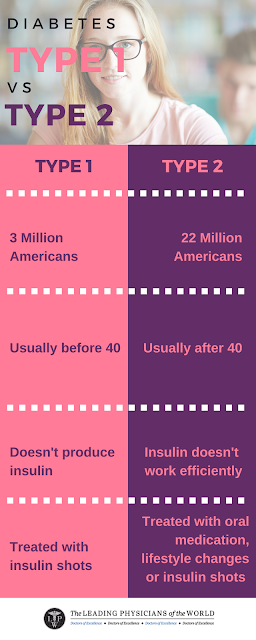Diabetes Type 1 vs Type 2
According
to the American Diabetes Association, 1.4 million Americans are diagnosed with
diabetes each year. And 86 million people in the United States
with prediabetes are headed towards developing Type 2 diabetes.
Diabetes is not unique to the United States.Moreover, it’s a global issue,
affecting hundreds of millions of people worldwide. When people are diagnosed
with diabetes, they often have many questions, especially about the differences
between Type 1and Type 2 diabetes. There are, in fact, multiple different
forms of diabetes, but the more common forms are Type 1 and Type 2.
How are they alike?
Both types
of diabetes greatly increase a person's risk for a range of serious
complications. Although monitoring and managing the disease can prevent
complications, diabetes remains the leading cause of blindness and kidney
failure. It also continues to be a critical risk factor for heart
disease, stroke, and foot or leg amputations. Also, Type 1 and type 2
diabetes share the problem of high levels of blood sugar. The inability to
control blood sugar causes the symptoms and the complications of both types of
diabetes. Type 1 diabetes affects just 5 percent of those adults, with type 2
diabetes affecting up to 95 percent.
Causes of type 1 diabetes
The body’s
immune system is responsible for fighting off foreign invaders, like harmful
viruses and bacteria. In people with type 1 diabetes, the immune system
mistakes the body’s own healthy cells for foreign invaders. The immune system attacks
and destroys the insulin-producing beta cells in the pancreas. After these beta
cells are destroyed, the body is unable to produce insulin.Researchers don’t
know why the immune system attacks the body’s own cells. It may have something
to do with genetic and environmental factors, like exposure to viruses.
Causes of type 2 diabetes
People with
type 2 diabetes have insulin resistance. The body still produces insulin, but
it’s unable to use it effectively. Researchers aren’t sure why some people
become insulin resistance and others don’t, but several lifestyle factors may
contribute, including excess weight and inactivity.Other genetic and
environmental factors may also contribute. When you develop type 2 diabetes,
your pancreas will try to compensate by producing more insulin. Because your
body is unable to effectively use insulin, glucose will accumulate in your
bloodstream.
How are type 1 and type 2 diabetes diagnosed?
The primary
test for both type 1 and type 2 diabetes is known as the glycated hemoglobin
(A1C) test. An A1C test is a blood test that determines your average blood
sugar level for the past two to three months. Your doctor may draw your blood
or give you a small finger prick.The higher your blood sugar levels have been
over the past few months, the higher your A1C level will be. An A1C level of
6.5 or higher indicates diabetes.
How are type 1 and type 2 diabetes treated?
There’s no
cure for type 1 diabetes. People with type 1 diabetes don’t produce insulin, so
it must be regularly injected into your body. Some people take injections into
the soft tissue, such as the stomach, arm, or buttocks, several times per day. Some
people use insulin pumps. Insulin pumps supply a steady amount of insulin into
the body through a small tube.Blood sugar testing is an essential part of
managing type 1 diabetes, because levels can go up and down quickly.Type 2
diabetes can be controlled and even reversed with diet and exercise, but many
people need extra support. If lifestyle changes aren’t enough, your doctor may
prescribe medications that help your body use insulin more effectively.
There’s
certainly a lot to having either form of diabetes, and it’s hard to do this on
your own. Seek out support and information from your health-care team, online
communities, and credible websites to educate yourself,
stay informed, and keep abreast of new developments and therapies.




Comments
Post a Comment